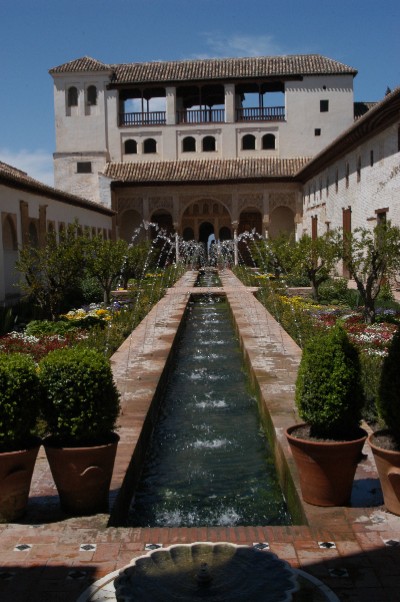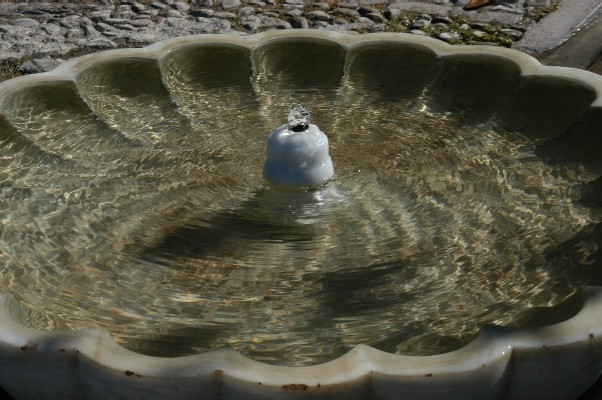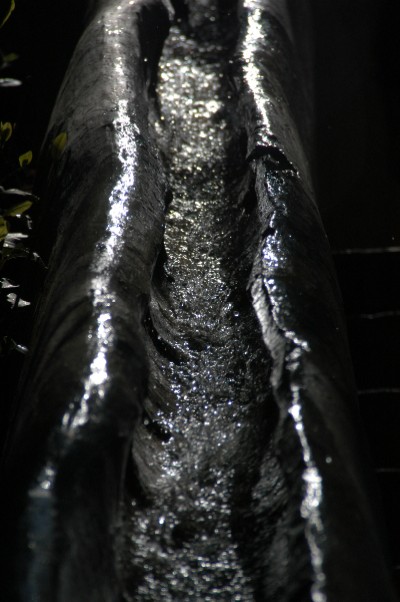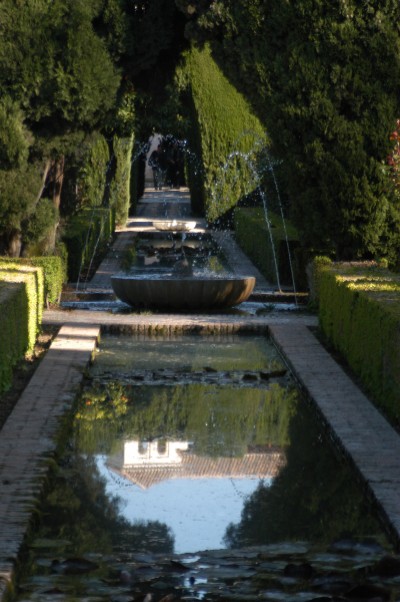 THE ALHAMBRA "Part Four" A section of the Partal was also dedicated to the burial of the sultan and his family. The word for cemetery and garden were synonymous as a garden is the Islamic ideal of paradise. The graves were removed when the last Sultan left Granada but the cemetery area has been maintained. THE ALHAMBRA "Part Four" A section of the Partal was also dedicated to the burial of the sultan and his family. The word for cemetery and garden were synonymous as a garden is the Islamic ideal of paradise. The graves were removed when the last Sultan left Granada but the cemetery area has been maintained.
After walking the length of the Partal and back again we exited to visit the Alcazaba, the oldest feature of the Alhambra, built in 899,. The thick fortification was a small military city in its own right before the construction of the more extensive walls and the palaces. The original lodgings are in ruins but the towers provided the best views of Granada and the surrounding countryside. The largest tower, the Torre de la Vela reached an imposing 27 meters at the far end of the ridge. The Alcazaba remained the place where military lived throughout the life of the Alhambra and even had a small garden built between some filled in ramparts.
Crossing back through the length of the Alhambra, we made diversions to see some of the fortified gates. The most interesting of the gates was the Justice Gate, built in a zigzagging design to prevent intruders. On the outside of the gate a large hand of Fatima (Mohammad's daughter)  reached with it five fingers pointed down over the horseshoe arched door way. The five fingers represented the five pillars of Islam - prayer, annual fasting (Ramadan), paying alms, the pilgrimage to Mecca, and the belief in one God and the prophet Mohammad. The horseshoe design of the doorway, which has become a trademark feature of Islamic art, actually originated with the Visigoths and was brought back to the greater Islamic world from the Iberian peninsula. Above one of the gates inner doors stood a Gothic Virgin that was added by the Catholic monarchs. Above the last door was a key with tassel, part of the arms of the Nasarid dynasty. An inscription on the gate read: " May God allow the justice of Ilsam to prevail within". In just one small structure remained a fascinating testimony to the Alhambra's dramatic history. reached with it five fingers pointed down over the horseshoe arched door way. The five fingers represented the five pillars of Islam - prayer, annual fasting (Ramadan), paying alms, the pilgrimage to Mecca, and the belief in one God and the prophet Mohammad. The horseshoe design of the doorway, which has become a trademark feature of Islamic art, actually originated with the Visigoths and was brought back to the greater Islamic world from the Iberian peninsula. Above one of the gates inner doors stood a Gothic Virgin that was added by the Catholic monarchs. Above the last door was a key with tassel, part of the arms of the Nasarid dynasty. An inscription on the gate read: " May God allow the justice of Ilsam to prevail within". In just one small structure remained a fascinating testimony to the Alhambra's dramatic history.
The last remaining part of our tour was the smaller Generalife Palace and Gardens that stood separate from the fortified  core of the Alhambra. This was the sultan's vacation palace and was done in much less elaborate style but the gardens but still featured beautiful courtyards and calm reflecting pools. The original design of the gardens is lost to history and the remaining pools were only just uncovered from the overgrowth in in the 1900s. Restoration of the area was completed in 1951. The labyrinth of tall hedges certainly reminded me more of European gardens but the long reflecting pools that stretched the length of the lower gardens had the distinct feel of a Muslim Garden. A key feature of a Muslim garden is that it can be experienced with all of the senses. There is the sight of the flowers, the sound of water, and the taste of fruits picked straight from the trees. core of the Alhambra. This was the sultan's vacation palace and was done in much less elaborate style but the gardens but still featured beautiful courtyards and calm reflecting pools. The original design of the gardens is lost to history and the remaining pools were only just uncovered from the overgrowth in in the 1900s. Restoration of the area was completed in 1951. The labyrinth of tall hedges certainly reminded me more of European gardens but the long reflecting pools that stretched the length of the lower gardens had the distinct feel of a Muslim Garden. A key feature of a Muslim garden is that it can be experienced with all of the senses. There is the sight of the flowers, the sound of water, and the taste of fruits picked straight from the trees.
Inside the Generalife Palace were two small but unique garden courtyards. The first was the Watergarden Courtyard which was only discovered in 1958 and restored to its current state. The long narrow pool was, at one time, modified with water spouts that create a web of water down the length of the pool but the plants have been restored using indigenous varieties making the courtyard typical of a Spanish-Moorish design. The Cypress Tree Courtyard was predominately a courtyard of water with a cypress tree in the center. Stairs left the Cypress Tree Courtyard and led to the upper gardens.
The upper gardens consisted of more tiers of sculpted gardens that sloped up to a lookout tower at the top of the  hill. One of the few genuine Nasarid features left in the whole of the Alhambra was the water stairway that led to the lookout tower. This long stair case had "railing" made of two continuous canals that ran from the top of the stairs to the bottom. Water rushed down the canals, bending around the stairs and into a tunnel at the end. This was all part of the elaborate water system that fed the Alhambra. From six kilometers up stream, two canals were spit from the river, one going through the water system of the Generalife and the other feeding a reservoir. The two reconnect to go over the aqueduct into the Alhambra. hill. One of the few genuine Nasarid features left in the whole of the Alhambra was the water stairway that led to the lookout tower. This long stair case had "railing" made of two continuous canals that ran from the top of the stairs to the bottom. Water rushed down the canals, bending around the stairs and into a tunnel at the end. This was all part of the elaborate water system that fed the Alhambra. From six kilometers up stream, two canals were spit from the river, one going through the water system of the Generalife and the other feeding a reservoir. The two reconnect to go over the aqueduct into the Alhambra.
Visiting the entirety of the Alhambra took the better part of a day but we could have enjoyed even longer. We revisited all of the gardens when Jose Luis joined us for the weekend and still weren't tired of the place. It is a truly unique and beautiful place. |

